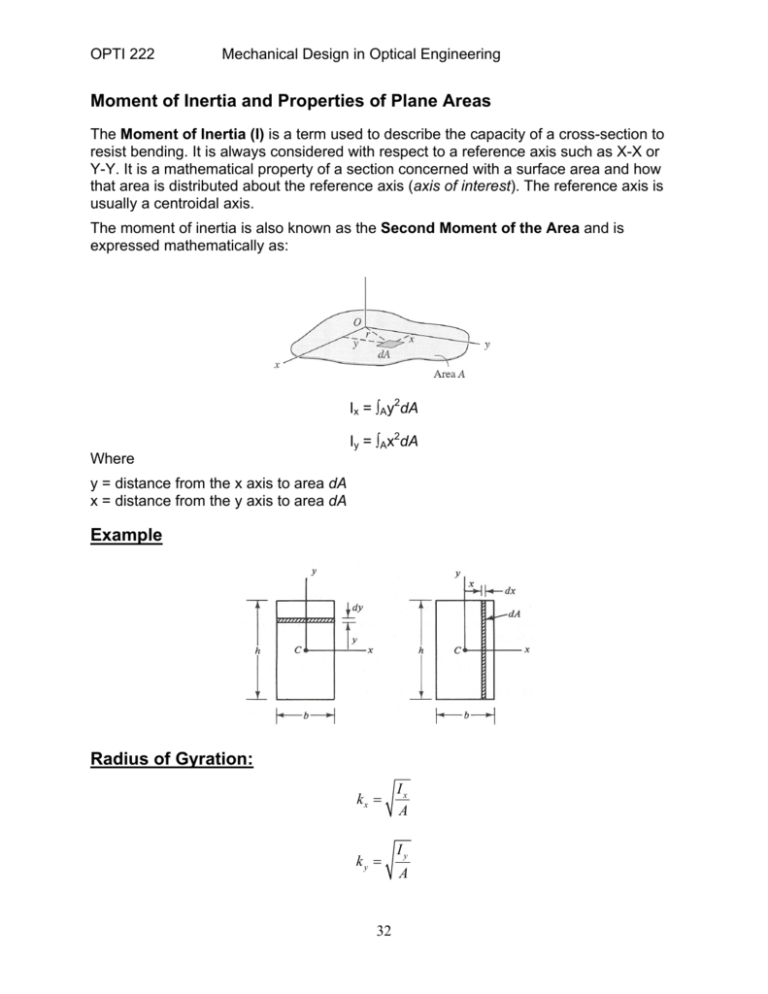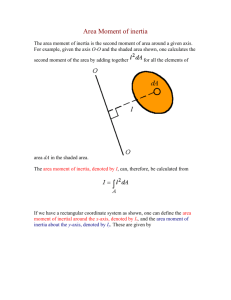Moment of Inertia and Properties of Plane Areas Example Radius of
advertisement

OPTI 222 Mechanical Design in Optical Engineering Moment of Inertia and Properties of Plane Areas The Moment of Inertia (I) is a term used to describe the capacity of a cross-section to resist bending. It is always considered with respect to a reference axis such as X-X or Y-Y. It is a mathematical property of a section concerned with a surface area and how that area is distributed about the reference axis (axis of interest). The reference axis is usually a centroidal axis. The moment of inertia is also known as the Second Moment of the Area and is expressed mathematically as: Ix = ∫Ay2dA Where Iy = ∫Ax2dA y = distance from the x axis to area dA x = distance from the y axis to area dA Example Radius of Gyration: kx = ky = 32 Ix A Iy A OPTI 222 Mechanical Design in Optical Engineering The radius of gyration of an area with respect to a particular axis is the square root of the quotient of the moment of inertia divided by the area. It is the distance at which the entire area must be assumed to be concentrated in order that the product of the area and the square of this distance will equal the moment of inertia of the actual area about the given axis. In other words, the radius of gyration describes the way in which the total cross-sectional area is distributed around its centroidal axis. If more area is distributed further from the axis, it will have greater resistance to buckling. The most efficient column section to resist buckling is a circular pipe, because it has its area distributed as far away as possible from the centroid. Rearranging we have: Ix = kx2A Iy = ky2A The radius of gyration is the distance k away from the axis that all the area can be concentrated to result in the same moment of inertia. Polar Moment of Inertia: Ip = ∫Aρ2dA Ip = ∫A(x2 + y2)dA Ip = ∫Ax2dA + ∫Ay2dA I p = Ix + Iy In many texts, the symbol J will be used to denote the polar moment of inertia. Shear stress formula J = I x + Iy τ= Tr J Product of Inertia: Ixy = ∫AxydA Consider the following: If an area has at least one axis of symmetry, the product of inertia is zero. 33 OPTI 222 Mechanical Design in Optical Engineering Properties of Plane Areas 34 OPTI 222 Mechanical Design in Optical Engineering Properties of Plane Areas Parallel Axis Theorem: Ix = Ixc + Ad2 Iy = Iyc + Ad2 The moment of inertia of an area with respect to any given axis is equal to the moment of inertia with respect to the centroidal axis plus the product of the area and the square of the distance between the 2 axes. The parallel axis theorem is used to determine the moment of inertia of composite sections. 35 OPTI 222 Mechanical Design in Optical Engineering Example 36









